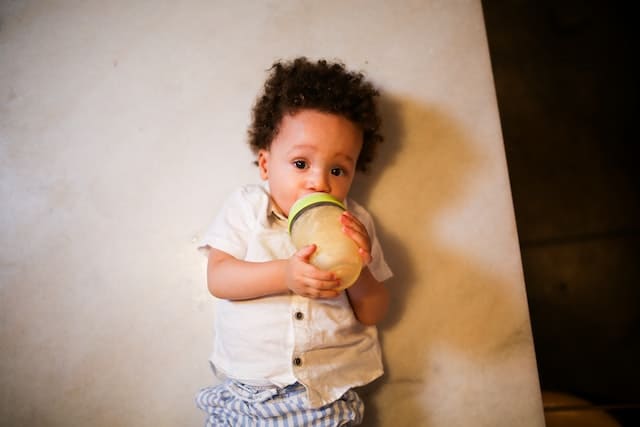It’s not uncommon for babies to cry while drinking from a bottle, and it can be frustrating for parents who are trying to feed their little ones.
There are a variety of reasons why a baby may cry during bottle feeding, and understanding these reasons can help parents identify the cause and find a solution.
One reason why a baby may cry while drinking from a bottle is that they are experiencing discomfort or pain. This could be due to a variety of factors, such as reflux, gas, or an ear infection. Another reason could be that the baby is simply hungry and wants to eat more quickly than they are able to.
In some cases, the baby may be overstimulated or overwhelmed, which can make it difficult for them to focus on eating.
It’s important for parents to be patient and try different strategies to soothe their baby during bottle feeding. This may include adjusting the feeding position, using a different type of bottle or nipple, or taking breaks during the feeding to burp the baby.
In some cases, it may be necessary to seek medical help if the crying persists or is accompanied by other symptoms.
Key Takeaways
- There are many reasons why a baby may cry while drinking from a bottle, including discomfort, hunger, and overstimulation.
- Parents can try different strategies to soothe their baby during bottle feeding, such as adjusting the feeding position or using a different type of bottle.
- If the crying persists or is accompanied by other symptoms, it may be necessary to seek medical help.
Understanding Baby Crying While Bottle Feeding
Babies cry for various reasons, and crying during bottle feeding is not uncommon. It can be frustrating for both the baby and the caregiver, but it is essential to understand the reasons behind it.
Possible Reasons for Baby Crying While Bottle Feeding
There are several reasons why a baby might cry while bottle feeding, including:
- Hunger: If the baby is still hungry, they might cry for more milk.
- Nipple confusion: If the baby is used to breastfeeding, they might get confused with the bottle’s nipple, leading to frustration and crying.
- Gas: Gas can cause discomfort and pain, leading to crying during feeding.
- Overfeeding: Overfeeding can cause discomfort and pain, leading to crying during feeding.
- Teething: Teething can cause discomfort and pain, leading to crying during feeding.
How to Address Baby Crying While Bottle Feeding
To address baby crying while bottle feeding, it is essential to identify the underlying cause. Some possible solutions include:
- Adjusting the feeding position: Try different feeding positions to see if it helps the baby feel more comfortable.
- Checking the nipple flow: Make sure the nipple flow is appropriate for the baby’s age and needs.
- Burping: Burping the baby frequently during feeding can help release gas and prevent discomfort.
- Taking breaks: Taking breaks during feeding can help the baby relax and prevent overfeeding.
- Offering a teething toy: Offering a teething toy before or after feeding can help soothe teething pain.
When to Seek Medical Attention
If the baby’s crying during bottle feeding is severe or persistent, it is essential to seek medical attention. It could be a sign of an underlying medical condition, such as reflux or an allergy.
In conclusion, understanding the reasons behind baby crying while bottle feeding and addressing them appropriately can help make feeding time more comfortable for both the baby and caregiver.
Causes of Crying During Bottle Feeding
Bottle feeding is an essential aspect of infant care, but it can be frustrating when a baby cries during feeding time.
There are several reasons why a baby may cry while bottle feeding, and it is important for parents to identify the cause to address the issue effectively.
Hunger
The most common reason for a baby to cry during bottle feeding is hunger. Babies have small stomachs, and they may need to be fed frequently.
If a baby is crying during feeding time, it may be a sign that they are hungry and need more milk. Parents can try increasing the amount of milk they give to their baby or feeding them more frequently.
Discomfort
Another common reason for a baby to cry during bottle feeding is discomfort. Babies may experience discomfort if the nipple flow is too slow or too fast, or if the milk is too hot or too cold.
Parents can try adjusting the nipple flow or the temperature of the milk to make feeding more comfortable for their baby.
Reflux
Acid reflux is a condition that can cause a baby to cry during feeding time. Reflux occurs when stomach acid flows back up into the esophagus, causing pain and discomfort.
Parents can try feeding their baby smaller amounts of milk more frequently, keeping them upright during and after feeding, and avoiding overfeeding.
Teething
Teething can also cause a baby to cry during feeding time. The pressure of sucking on a bottle can exacerbate teething pain, making feeding uncomfortable for babies. Parents can try giving their baby a teething toy or a chilled washcloth to help alleviate teething pain before feeding.
Colic
Colic is a condition that can cause a baby to cry for long periods of time, often during feeding time. The cause of colic is unknown, but it is believed to be related to gastrointestinal discomfort.
Parents can try adjusting their baby’s feeding position, using a slow flow nipple, and reducing distractions during feeding time to help alleviate colic symptoms.
In conclusion, there are several reasons why a baby may cry during bottle feeding, including hunger, discomfort, reflux, teething, and colic.
Parents can try adjusting their feeding routine and addressing the root cause of their baby’s discomfort to make feeding time more comfortable and enjoyable for both the baby and the caregiver.
Feeding Positions and Techniques
Breastfeeding Positions
When breastfeeding, the mother should choose a comfortable position that allows the baby to latch onto the breast correctly. The most common breastfeeding positions include the cradle hold, cross-cradle hold, football hold, and side-lying position.
In the cradle hold, the baby is held in the mother’s arm on the same side as the breast being used. In the cross-cradle hold, the baby is held in the opposite arm.
The football hold involves holding the baby under the arm, with the baby’s legs tucked under the mother’s arm. The side-lying position allows the mother to lie down while breastfeeding.
Bottle Feeding Positions
When bottle feeding, the baby should be held in an upright position to prevent choking. The most common bottle feeding positions include the cradle hold, cross-cradle hold, and football hold.
In the cradle hold, the baby is held in the crook of the arm, with the head supported by the hand. In the cross-cradle hold, the baby is held in the opposite arm, with the head supported by the hand.
The football hold involves holding the baby under the arm, with the head supported by the hand.
Paced Bottle Feeding
Paced bottle feeding is a technique that mimics breastfeeding and helps prevent overfeeding. The baby is held in an upright position, and the bottle is held parallel to the ground.
The baby is allowed to take breaks and breathe between sucks, and the bottle is tipped downward to allow the baby to control the flow of milk. This technique helps prevent the baby from becoming overwhelmed and helps prevent gas and colic.
Overall, choosing the right feeding position and technique can help prevent feeding problems and ensure that the baby is getting enough milk.
Dealing with Feeding Problems
Feeding problems are common among babies, and one of the most common issues is a baby crying while drinking a bottle. This can be frustrating for parents and caregivers who want to ensure their baby is getting the nutrition they need.
There are several reasons why a baby may cry during bottle-feeding, including behavioral reasons and underlying medical conditions.
If a baby is consistently crying during bottle-feeding, it is important to first check the feeding schedule and ensure the baby is not hungry.
Additionally, checking the diaper for any discomfort or wetness can also help alleviate feeding problems. If these basic needs are met and the baby is still crying, it may be a sign of a bottle-feeding problem.
There are several bottle-feeding problems that can cause a baby to cry, including issues with the nipple or the flow of milk. It is important to choose the right nipple size and shape for the baby’s age and needs.
Additionally, making sure the baby is in a comfortable position during feeding can help prevent feeding problems.
If the root cause of the feeding problem is not immediately clear, it may be necessary to consult with a doctor or pediatrician. They can help identify any underlying medical conditions that may be causing the baby to cry during feeding.
Overall, dealing with feeding problems can be challenging, but with patience and persistence, parents and caregivers can help ensure their baby is getting the nutrition they need.
Understanding Baby’s Feeding Schedule
Babies have unique feeding schedules that may vary from one baby to another. Understanding your baby’s feeding schedule can help you avoid feeding problems such as baby crying and squirming during feeding.
It is important to note that babies have small stomachs, and they may need to feed more frequently than adults. In general, babies need to be fed every two to three hours, or whenever they show signs of hunger.
Some babies may want more milk than expected, while others may be content with less.
Parents should also pay attention to their baby’s cues to avoid overfeeding or underfeeding. Signs that a baby is hungry include sucking on their fingers, smacking their lips, and rooting.
On the other hand, signs that a baby is full include turning their head away from the bottle, falling asleep, or pushing the bottle away.
Parents should also be aware that babies may experience feeding problems such as baby crying and squirming during feeding. These problems may be caused by a variety of factors, including discomfort, illness, or a slow flow rate.
Parents can try different feeding positions or bottle nipples to help alleviate these problems.
In summary, understanding your baby’s feeding schedule is crucial to ensuring that they receive the right amount of nutrition.
By paying attention to your baby’s cues and addressing any feeding problems, you can help ensure that feeding time is a comfortable and enjoyable experience for both you and your baby.
When to Seek Medical Help
While it is normal for babies to cry during feedings, excessive crying or fussiness can be a sign of an underlying issue.
In most cases, a crying baby can be soothed with a change in position, a burp, or a break from feeding. However, there are times when a parent should seek medical help for their baby.
Reflux and Colic
If a baby is consistently crying during feedings and seems to be in pain, they may have reflux or colic. Reflux occurs when the contents of the stomach come back up into the esophagus, causing discomfort and pain.
Colic is a term used to describe excessive crying in otherwise healthy babies. If a baby has reflux or colic, a doctor may recommend changes to their feeding routine or medication to alleviate symptoms.
Illness
If a baby is crying during feedings and also has a fever, diarrhea, or vomiting, they may be sick. In this case, it is important to seek medical help right away, as these symptoms can be a sign of a serious illness.
Lactose Intolerance and Allergies
If a baby is consistently fussy during feedings and has other symptoms such as diarrhea or a rash, they may have a lactose intolerance or an allergy. Lactose intolerance occurs when a baby cannot digest lactose, a sugar found in milk.
An allergy occurs when a baby’s immune system reacts to a certain food. If a baby has a lactose intolerance or an allergy, a doctor may recommend changes to their diet or medication to alleviate symptoms.
Acid Reflux and Silent Reflux
Acid reflux and silent reflux are two types of reflux that can cause a baby to cry during feedings. Acid reflux occurs when stomach acid comes back up into the esophagus, causing discomfort and pain.
Silent reflux occurs when stomach acid comes back up into the throat, causing discomfort and pain without spitting up. If a baby has acid reflux or silent reflux, a doctor may recommend changes to their feeding routine or medication to alleviate symptoms.
In general, if a parent is concerned about their baby’s crying during feedings, they should seek medical help. A doctor can help determine the underlying issue and recommend the best course of treatment for the baby.
Transitioning to Solids
As babies grow, they start to develop the ability to eat solid foods. It is usually recommended to start introducing solids between 4 and 6 months of age.
However, it is important to note that breast milk or formula should still be the primary source of nutrition for babies until they are at least 1 year old.
When transitioning to solids, it is important to choose age-appropriate foods and to introduce them gradually. Start with simple purees or soft foods, such as mashed bananas or cooked sweet potatoes.
As the baby becomes more comfortable with eating solids, other foods can be introduced.
It is also important to consider the size of the nipple on the bottle. As babies start to eat more solid foods, they may need a larger nipple size to accommodate the thicker consistency of the food.
It is recommended to switch to a nipple with a larger hole size when necessary.
Overall, transitioning to solids is an exciting milestone for both parents and babies. With careful consideration and gradual introduction of new foods, babies can continue to grow and develop while still receiving the necessary nutrition from breast milk or formula.
Tips to Soothe a Crying Baby
Crying is a natural way for babies to communicate, but it can be stressful for parents, especially when the baby is crying while drinking a bottle. Here are some tips to help soothe a crying baby:
1. Fussing and Tiredness
If the baby is fussing or seems tired, try to comfort them by gently rocking them or patting their back. Sometimes a change of position can also help.
If the baby is lying down, try holding them upright or sitting them up. If they are sitting up, try lying them down. The change in position can help to calm them down.
2. Distraction
Sometimes a baby can get distracted while drinking a bottle, especially if there are other noises or activities going on around them. Try to create a quiet and calm environment for feeding time. Turn off the TV or radio, and try to limit other distractions.
3. Baby Carrier
Using a baby carrier or sling can be a great way to soothe a crying baby. The closeness and movement can help to calm them down. Make sure to follow the instructions for the carrier or sling to ensure that the baby is safe and secure.
4. Burping
If the baby is crying while drinking a bottle, it could be a sign that they need to burp. Stop feeding and gently pat or rub their back until they burp. This can help to release any trapped air and make them more comfortable.
5. Overtired Baby
An overtired baby can be difficult to soothe. If the baby is crying while drinking a bottle, it could be a sign that they are overtired. Try to establish a consistent sleep routine and make sure that the baby is getting enough sleep during the day.
6. Pregnancy
If the mother is pregnant, the baby may be able to sense changes in hormones or mood. Try to create a calm and relaxing environment for feeding time. Take deep breaths and try to remain calm and patient.
By following these tips, parents can help to soothe a crying baby and make feeding time a more enjoyable experience for both the baby and the parents.
Related: Baby Pushes Away When Held
Frequently Asked Questions
Why does my baby cry while eating formula?
There can be several reasons why a baby may cry while feeding. One of the most common reasons is that the baby is experiencing discomfort due to gas or reflux.
Another reason could be that the flow of milk is too slow or too fast, causing frustration for the baby. It is also possible that the baby is simply tired or overstimulated.
What can I do if my baby squirms and cries while bottle feeding?
If your baby is squirming and crying during bottle feeding, try to calm them down by gently rocking them or singing to them. You can also try changing their position or burping them to relieve any discomfort from gas.
If the flow of milk is too fast, try using a slower flow nipple. If the baby is still fussy, take a break and try feeding them again in a few minutes.
How can I help my 3 month old stop crying during bottle feeding?
If your 3 month old is crying during bottle feeding, try to identify the cause of their discomfort. Check the temperature of the milk, the flow of the nipple, and the baby’s position.
You can also try burping the baby frequently and taking breaks during the feeding. If the baby is still fussy, try using a pacifier or offering a small amount of water in between feedings.
Why does my baby kick and flail arms and legs while bottle feeding?
Babies may kick and flail their arms and legs during bottle feeding as a way to release energy or express frustration. It could also be a sign that the flow of milk is too slow or too fast. Try adjusting the flow of the nipple or changing the baby’s position to see if it helps.
What can I do if my baby makes loud noises while bottle feeding?
Loud noises during bottle feeding are normal and may indicate that the baby is enjoying the feeding.
However, if the noises are excessive or accompanied by crying or discomfort, it could be a sign of gas or reflux. Try adjusting the flow of the nipple or burping the baby to relieve any discomfort.
How can I soothe my baby if they cry during bottle feeding at night?
If your baby is crying during bottle feeding at night, try to keep the environment calm and quiet. Use a night light to avoid overstimulation and avoid talking or playing with the baby.
Try to keep the feeding short and offer a pacifier or a small amount of water to help soothe the baby back to sleep.
Related Post: Why Do I Get So Mad At My Baby! Anger Management Tips For Parents
https://www.youtube.com/watch?v=Nfxmn2ok-iw

Nurse Practitioner at Venus Med Spa



